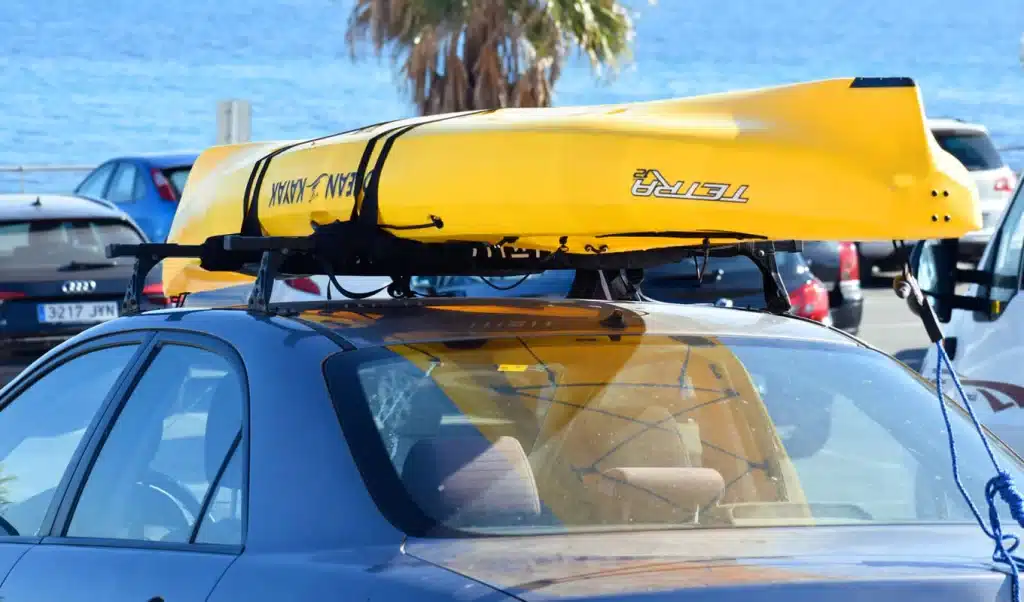Table of Contents
One of the most important parts of kayaking is transporting your kayak safely and securely. This will maintain your kayak and give you piece of mind. Knowing the best ways to move your kayak can make your journeys more stress-free and pleasurable, regardless of experience level. Everything you need to know about utilizing different techniques and gear to transport a kayak will be covered in this article.
Kayaks can be heavy and difficult to move around, particularly around busy roads or large distances. You risk breaking your kayak or car or even getting into an accident if you don’t have the right equipment and know-how. Thankfully, there are a number of practical kayak carrying options, ranging from traditional roof rack systems to creative kayak trailers and simple foam blocks. To ensure your kayak stays safely in place, we’ll go over each technique in detail, highlighting the need for kayak-like bow and stern lines, cam buckles, and tie-down straps. We’ll also advise people without roof racks, with options for all kinds of cars. You can carry your kayak safely with the correct information and planning, freeing you up to enjoy the excitement and adventure that awaits you on the water.
Lets explore 10 Best Places to Kayak lets delve into the details and Make Your Sea Adventures Breathtaking
Knowledge of Rack Systems and Their Significance
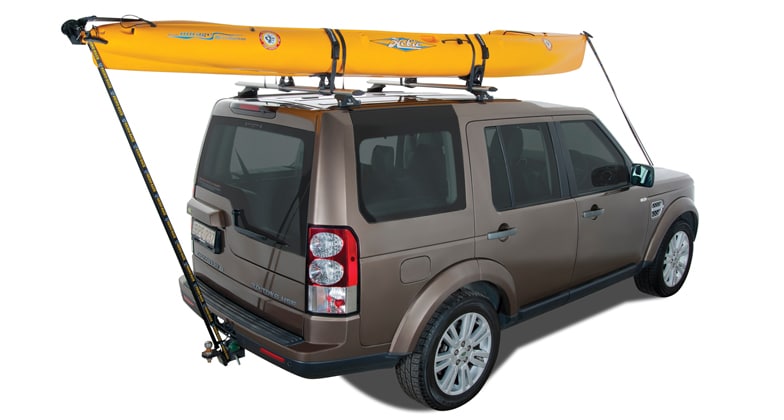
Kayaks cannot be transported in a car without a rack system. Different rack systems cater to different purposes and vehicle types. The main objective is to safely fasten your kayak so it doesn’t get damaged while transported.
The Roof Rack System’s Use
One of the most popular and efficient ways to transport a kayak is with a roof rack system. It is made up of bars that fasten to your car’s roof and give you a stable platform to carry your kayak. Here’s how to use a roof rack system to move a kayak:
Filling a Kayak: Carefully place the kayak on the roof rack system. The grab handle allows you to raise and position the kayak on the rack.
Tie-Down Straps: Secure the kayak using tie-down or cam straps. Tighten the straps around the kayak and roof rack to prevent them from moving.
Stern and Bow Lines: Use the bow and stern lines to secure the front and rear of the kayak. This extra safety measure helps stabilize the kayak, particularly when moving quickly.
Alternative methods to Transport a Kayak
Manta Racks with Foam Blocks
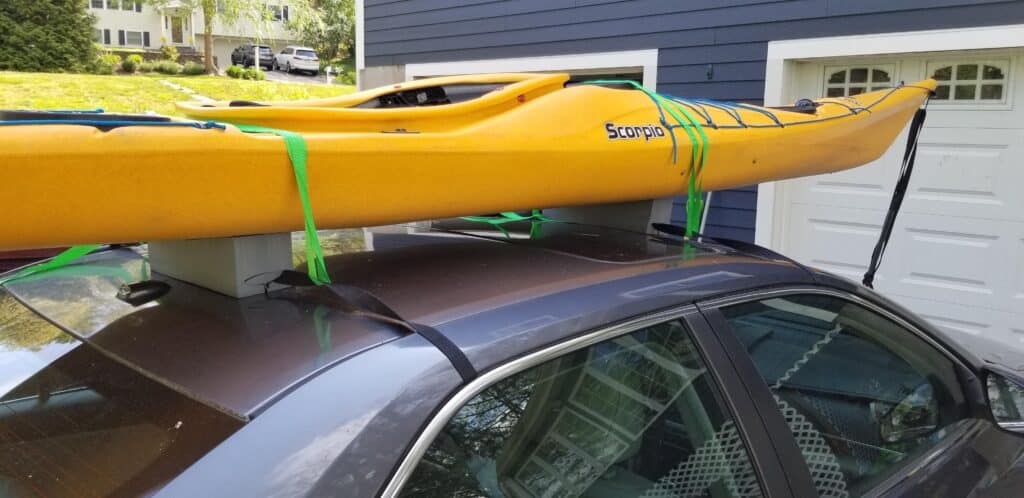
You can use foam blocks to carry your kayak even if your car doesn’t have a roof rack. These blocks act as a cushion to shield your car’s roof from dents and scratches caused by the kayak. Make sure the kayak is securely fastened to prevent any movement by using cam straps to secure it.
Another great choice for cars without conventional roof racks is manta racks. These racks are made to hold surfboards, paddleboards, and kayaks securely. They offer safe and secure mobility and have configurable features for various vehicle types.
Trailers for Kayaks: Perfect for Several Kayaks

A kayak trailer is a great option for anyone who needs to carry more than one kayak. Since they can accommodate multiple kayaks at once, kayak trailers are ideal for family or group trips. This is how a kayak trailer is used:
Filling Several Kayaks: Arrange the kayaks to be evenly spaced on the trailer racks.
Securing with Tie-Down Straps: Secure each kayak separately using tie-down or cam buckle straps.
Stern and Bow Lines: Secure each kayak using a bow and stern line to add additional security during transit.
Taking a Kayak Outside Without a Roof Rack
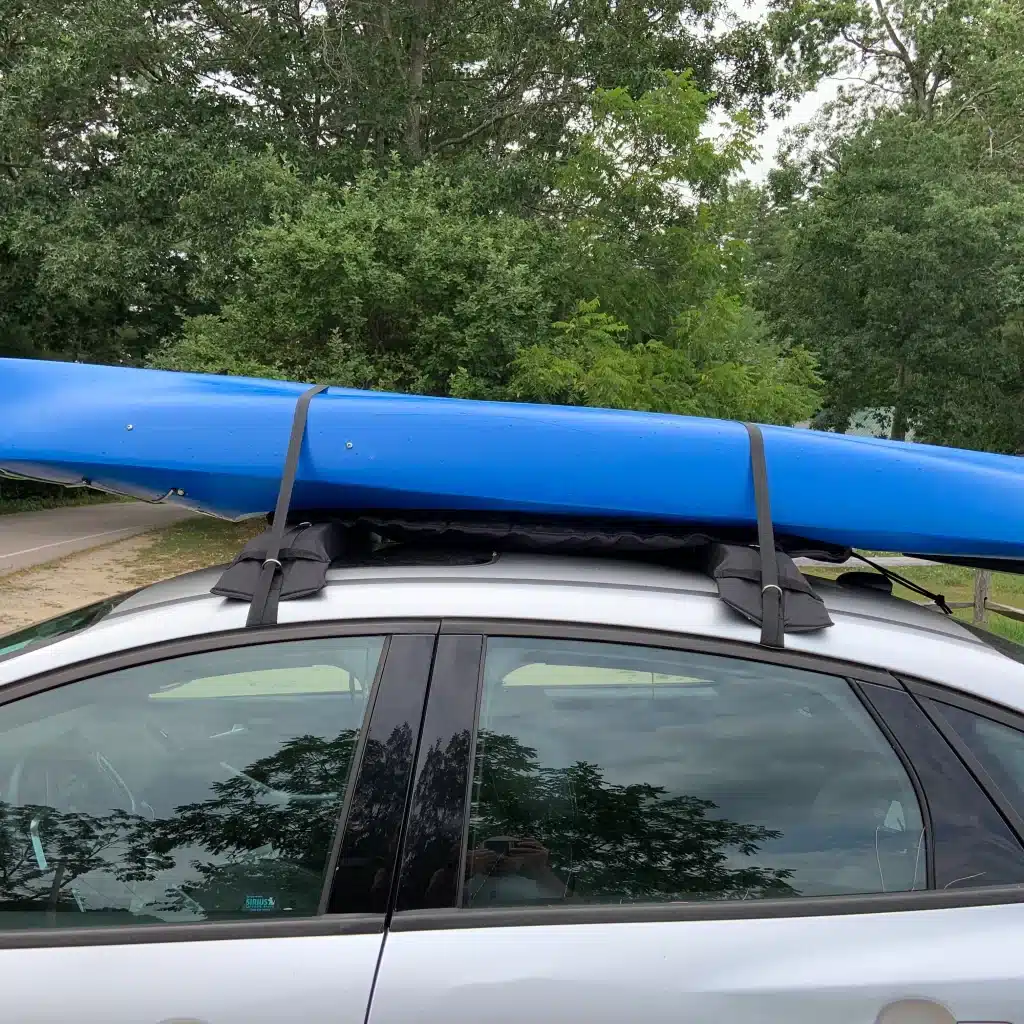
You can still carry your kayak safely even if you don’t have a trailer or roof rack. Here are a few techniques:
Inside a Truck: To transfer the kayak, place it inside the truck bed. Secure the kayak with tie-down straps so it doesn’t protrude too far out the rear of the truck. If needed, use a red flag to indicate the extended load.
How to Use a Kayak Rack: It is possible to mount a kayak rack on the bed of a truck without a roof rack. Like a roof rack system, this offers the kayak a safe basis.
How to Lock Down Your Kayak
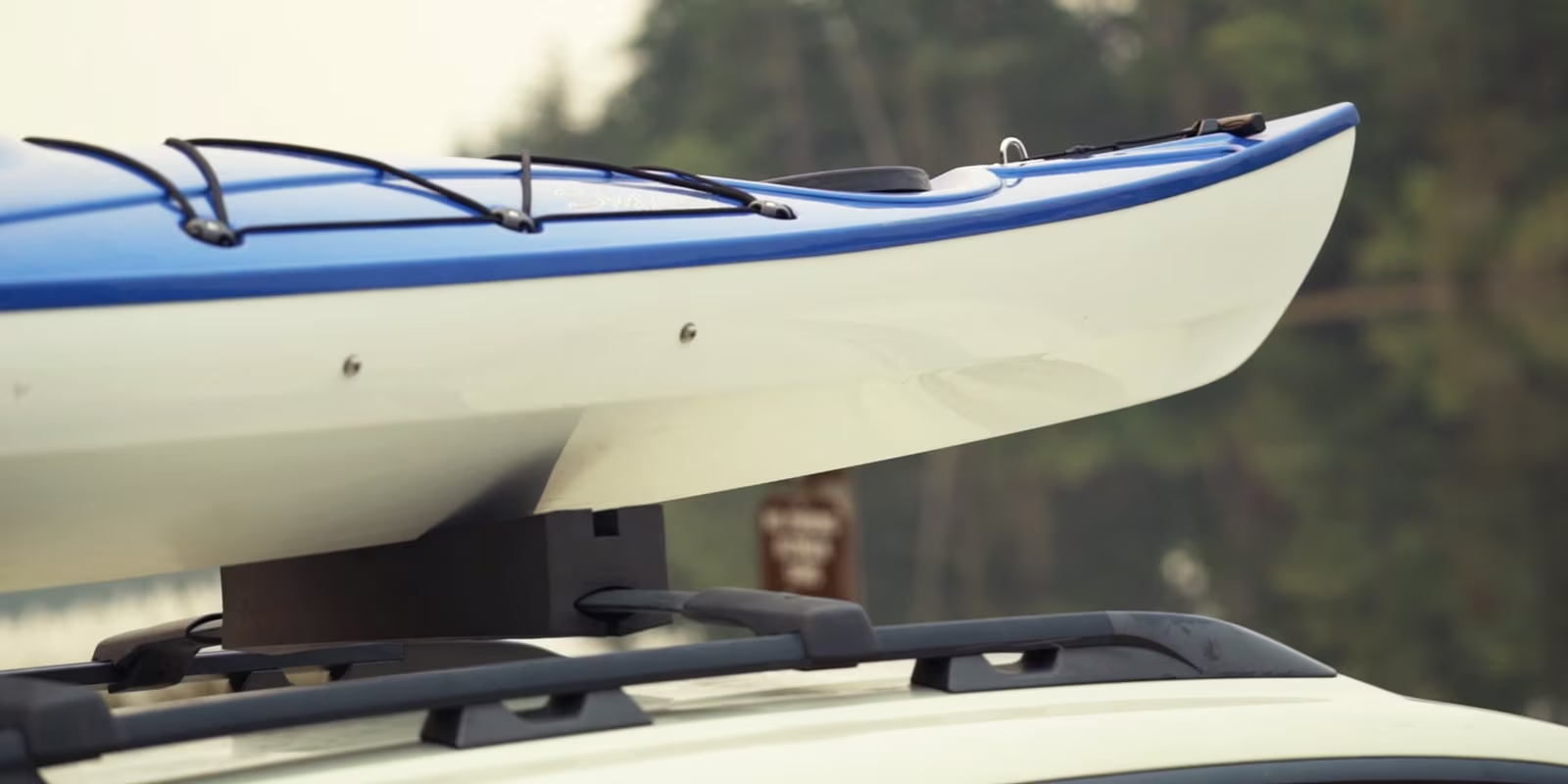
Whichever way you choose, make sure to take these essential steps to secure your kayak:
Use High-Quality Straps: To ensure your kayak is kept firmly in place, invest in high-quality tie-down or cam straps.
Examine the straps. Make sure the kayak is steady and all the straps are secure before you start driving.
Employ stern and bow lines: These lines keep the kayak from moving while being transported, particularly in windy conditions.
Don’t overtighten: The kayak’s hull may get damaged if the straps are overtightened. Make sure the straps are snug but not too tight.
Accessories for Kayak Transportation
Kayak transportation can be safer and easier with the following accessories:
Rod Holders: If you’re an angler, you can carry your fishing rods alongside your kayak by attaching rod holders to the rack or trailer.
Grab handles are handy when hoisting and guiding the kayak onto a car or trailer.
Cam Buckles: For securing kayaks, cam buckle straps work well and are easy to use. They give a solid grasp without requiring undue tightening.
Useful Advice on Transporting Kayaks
Make a Route Plan: Plan your route ahead of time to avoid low bridges and other hazards that could damage your kayak.
Drive cautiously: Steer clear of sudden turns and drive reasonably when transporting a kayak.
Frequent Inspections: During extended travel, periodically check the kayak and straps to ensure security.
How to Move Kayaks Using Various Cars
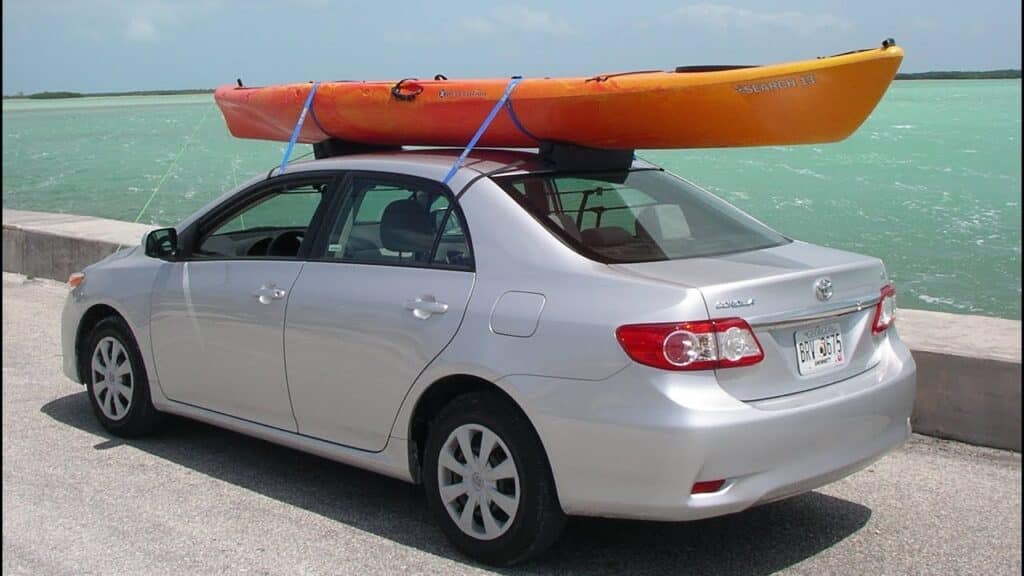
Carrying a Kayak in a Vehicle: Use foam blocks or a roof rack system. Use bow and stern lines for further stability, and fasten the kayak with cam straps.
To Transport a kayak in a truck involves putting it in the bed of a truck and tying it down with straps. A kayak rack might improve stability.
One way to transport kayaks is to put a kayak trailer on your car. Place the kayaks on the trailer racks and fasten them firmly using the bow and stern lines and cam buckle straps.
Conclusion
Transport a kayak safely and securely is critical to saving your gear and guaranteeing a hassle-free paddle to your destination. Whether you’re using a kayak trailer, foam blocks, or a roof rack system, you can carry your kayak with confidence if you have the correct equipment and know-how. Every technique has specific benefits that meet the needs of various vehicle types and kayakers.
For many individuals, a roof rack system is an easy and dependable option for transporting one or more kayaks. By using bow and stern lines, tie-down straps, and cam buckles, you can be confident that your kayak is secure even when traveling at fast speeds or across uneven terrain. Foam blocks and manta racks are a good substitute for a roof rack if your car doesn’t have one; they shield your car and kayak from harm.
A kayak trailer is a great option for carrying more than one kayak. It is ideal for family vacations and group trips since it has enough room and specially designed racks to accommodate multiple kayaks safely. Furthermore, you can improve your transport setup with attachments like grab handles and rod holders, making loading and unloading quicker and more effective.
It’s also important to remember useful advice like route planning to avoid low bridges, driving cautiously to accommodate the extra load, and routinely checking your straps when traveling long distances. By following these rules, you can ensure that your kayak reaches its destination undamaged and prepared for your next water trip.
In conclusion, selecting the appropriate technique and gear for your needs is the key to safely and securely carrying a kayak. Securing your kayak with high-quality straps and lines is crucial, regardless of whether you use a roof rack system, foam blocks, or a kayak trailer. With the right gear and preparation, you may enjoy peace of mind and concentrate on the fun of kayaking, knowing that your equipment is well-protected during travel.
